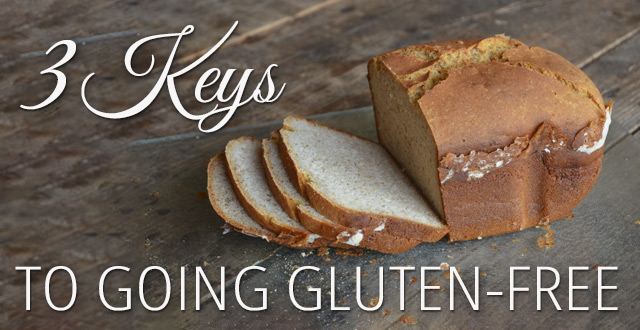As you age your body goes through many changes. A lifetime of eating habits may suddenly need to be adjusted if you find yourself feeling weak, tired, bloated or in pain when you eat certain foods. The onset of dietary allergies, intolerance or sensitivities can be gradual. Or it can hit you swiftly and cause major health problems. While the instance of Celiac Disease, an autoimmune disorder triggered by the presence of gluten remains steady (around 1% of the population), reports of gluten sensitivity is starkly on the rise.
Gluten is a naturally occurring protein found in many grains that has a thickening effect when cooked. Gluten is what makes bread fluffy when baked and why roux (cooked flour and fat) thickens stews. But is gluten bad for you? That depends on your individual biology. If you have Celiac Disease, yes gluten can make you very sick, malnourished, and can lead to organ failure and in some extreme cases death over time. If you have gluten sensitivity you can be exposed to moderate amounts of gluten without extreme pain or acute damage. But over time the inflammation it can cause may lead to gastrointestinal, mental and joint issues. Clouded thinking, fatigue and intermittent unexplained pain are common complaints of people who’ve found they suffer with gluten sensitivity.
Key 1) Identify Foods that Contain Gluten
Wheat
Wheat germ
Bulgur wheat
Couscous
Semolina
Spelt
Farina
Matzo
Rye
Barley
Graham flour
Kamut
Triticale
Wheat products
Sprouted wheat products (may cause adverse reactions in some people)
Vital wheat gluten or seitan
Wheat gluten additives
Corn gluten additives (may cause adverse reactions in some people)
Breaded foods
Tempura batter
Tabbouleh
Energy or protein bars (unless certified gluten-free)
French fries (often dusted with wheat flour)
Oats and oatmeal (unless certified gluten-free, often exposed to wheat flour)
Oat bran (unless certified gluten-free)
Hot dogs
Cold cuts
Sausage
Meatballs
Meatloaf
Veggie burgers (unless certified gluten-free)
Commercial soups (unless certified gluten-free)
Commercial bullion and broths (unless certified gluten-free)
Commercial ice cream (unless certified gluten-free)
Canned fruit fillings
Powdered pudding mixes
Refrigerated pudding
Root beer
Chocolate milk
Canned baked beans
Egg substitute
Imitation crab meat
Imitation bacon
Imitation meat products (unless certified gluten-free)
Commercial/Imitation syrup (unless certified gluten-free)
Wheatgrass
Instant hot drinks
Flavored coffee
Flavored tea
Roasted nuts
Malt
Malt flavoring
Malt vinegar
Barley malt syrup
Processed cheese product (e.g. spray cheese, American Singles, Velveeta, etc.)
Some blue cheeses (some artisanal cheeses are still made with bread mold)
Beer (unless certified gluten-free)
Wheat vodka
Wine coolers
Gravy
Mayonnaise (unless certified gluten-free)
Ketchup (unless certified gluten-free)
Soy sauce
Teriyaki sauce
Salad dressing (unless certified gluten-free)
Commercial marinades
Non-dairy creamer (unless certified gluten-free)
Key 2) Research How You Can Avoid Gluten
Miscellaneous sources of gluten:
Prescription medication
Vitamins and supplements
Shampoo
Cosmetics
Lipstick
Lip balm
Play-Doh
Dry glue stamps
Dry glue envelopes
Ingredient codes for gluten:
Avena sativa Cyclodextrin
Brown rice syrup
Caramel color (often made from barley)
Dextrin
Fermented grain extract
Hordeum distichon
Hordeum vulgare
Hydrolysate
Hydrolyzed malt extract
Hydrolyzed soy protein
Hydrolyzed vegetable protein or HVP
Maltodextrin
Modified food starch
Natural flavoring
Phytosphingosine extract
Samino peptide complex
Secale cereale
Tocopherol (vitamin E)
Triticum aestivum
Triticum vulgare
Yeast extract
Key 3) Find Other Ways to Help Your Body
Many people with gluten sensitivity also have other allergies, intolerances and sensitivities. These can include dairy, corn, tree nuts, and even apricots, bananas and kidney beans. Try to eat fresh, organic produce to minimize additives and preservatives. And make an effort to cook your own food or subscribe to a weekly fresh food delivery so you know exactly what’s going into your body.
Beginning your journey to becoming gluten free doesn’t have to be hard. Identify what contains gluten, find replacements, and look at other food issues you may have. You will need to read labels and research hidden sources of gluten to go completely gluten-free. This resource should give you a running start.

